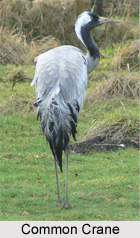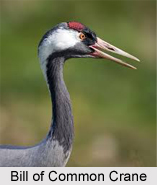 Common Crane is an Indian Bird with a scientific name "Grus grus" is concentrated in the regions of tropical countries.
Common Crane is an Indian Bird with a scientific name "Grus grus" is concentrated in the regions of tropical countries.
Common Crane is also known as the Eurasian crane. It is a medium-sized species. It is the only crane commonly found in Europe besides the Demoiselle crane (Anthropoides virgo). Along with the sand hill (Grus canadensis) and Demoiselle cranes and the brolga (Grus rubicunda), it is one of only four crane species not currently classified as threatened with extinction or conservation dependent at the species level.
Structure of Common Crane
Common crane is a large, stately bird and a medium-sized crane. It is 100-130 cm long with a 180-240 cm wingspan. The body weight can range from 3 to 6.1 kg, with the nominate subspecies averaging around 5.4 kg and the eastern subspecies averaging 4.6 kg. Among standard measurements, the wing chord is 50.7-60.8 cm (20.0-23.9 in) long, the tarsus is 20.1-25.2 cm and the exposed culmen is 9.5-11.6 centimetres.
Colour of Common Crane
Common Crane is slate-grey overall. The forehead and lores of Common crane are blackish with a bare red crown and a white streak extending from behind the eyes to the upper back. The overall colour of Common crane is darkest on the back and rump and palest on the breast and wings. The primaries, the tips of secondaries, the alula, the tip of the tail, and the edges of upper tail coverts are all black and the greater coverts droop into explosive plumes. This combination of colouration ultimately distinguishes it from similar species in Asian countries like Bangladesh, India and Pakistan, like the hooded and black-necked cranes.
Common Crane in Young Time
The juvenile Common crane has yellowish-brown tips to its body feathers and lacks the drooping wing feathers and the bright neck pattern of the adult, and has a fully feathered crown. Every two years, before migration, the adult common crane undergoes a complete moult, remaining flightless for six weeks, until the new feathers grow.
Sounds of Common Crane
Common Crane has a loud trumpeting call, given in flight and display. The call is piercing and can be heard from a considerable distance. It has a dancing display, leaping with wings uplifted.
Concentration of Common Crane
Common Crane is found in the northern parts of Europe and Asia. Formerly the species was spread as far west as Ireland, but about 200 years ago, it became extinct there. However, it has since started to return to Ireland naturally and there are now plans to help it return to Ireland on a greater scale. The common crane is an uncommon breeder in southern Europe, smaller numbers breeding in Greece, Yugoslavia, Romania, Denmark and Germany.
 Breeding Time of Common Crane
Breeding Time of Common Crane
The breeding populations of Common Crane can be found in Scandinavia, especially Finland and Sweden. The heart of the breeding population for the species is in Russia, however, where possibly up to 100,000 cranes of this species can be found seasonally. In Russia, it is distributed as a breeder from the Ukraine region to the Chukchi Peninsula. The breeding population extends as far south as Manchuria, now in China but almost the entire Asian breeding population is restricted to Russia.
Migration of Common Crane
Common Crane is a long distance migrant predominantly wintering in northern Africa. Autumn migration is from August to October and spring migration is in March through May. Important staging areas occur anywhere from Sweden and Germany to China and many thousand cranes can be seen in one day in the autumnal season. The bird of Common crane migrates from winter in southern Europe, including Portugal, Spain and France. Most eastern common cranes winter in the river valleys of Sudan, Ethiopia, Tunisia and Eritrea with smaller numbers in Turkey, northern Israel, Iraq and parts of Iran. The third major wintering region is in the northern half of Indian subcontinent, including Pakistan. The minimal wintering also occurs in Myanmar, Vietnam and Thailand. Lastly, they winter in eastern China, where they are often the most common crane.



















